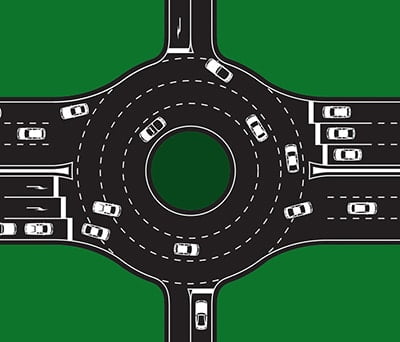Quiz: Dealing with particular situations at a roundabout
One of the main reasons why most people fail the Ontario G1 test is test nerves. If you panic, you’re more likely to make silly mistakes that could cost you the provisional license.
ADVERTISEMENT
Correct!
Wrong!
Correct!
Wrong!
Correct!
Wrong!
Share the quiz to show your results !
Subscribe to see your results
I got %%score%% of %%total%% right
More Learning Options:
Loading…
ADVERTISEMENT
Understanding Traffic Rules for Roundabouts
Roundabouts are designed to assist with traffic flow in certain areas. They are used instead of stop signs and stoplights. However, not everyone understands how to successfully use them, and that can create chaos. It can also increase the risk of an accident. Understanding how to use them correctly, especially in certain situations, can make a world of difference.
Large Vehicles
One of the issues that may come up when you need to go through a roundabout is larger vehicles. This includes buses and trucks. They need more room than your average vehicle to get through the roundabout. Being aware of this need and being courteous can help everyone stay safe. It also improves the flow of traffic.
Give them extra room as they have to swing widely as they go through the roundabout. Otherwise, they may hit a vehicle or hit the cement structure on the inside area. It is best to avoid being side by side of a larger vehicle as they go through a roundabout. Instead, give them the time to go through it on their own. You can go behind them to increase the overall safety of all involved.
Driving Larger Vehicles
 If you are behind the wheel of a larger vehicle, be cautious and aware as you enter a roundabout. Others around you may be careless, in a hurry, or simply not realize you need more space as you go around the traffic circle. Avoid being next to other vehicles if possible, allow them to speed up, and then continue on the path. You will need to swing wide, and you can’t do that successfully if there is another vehicle next to you.
If you are behind the wheel of a larger vehicle, be cautious and aware as you enter a roundabout. Others around you may be careless, in a hurry, or simply not realize you need more space as you go around the traffic circle. Avoid being next to other vehicles if possible, allow them to speed up, and then continue on the path. You will need to swing wide, and you can’t do that successfully if there is another vehicle next to you.
You will likely need to take up both lanes as you pass through the roundabout to your exit. Since it won’t take long to complete this, don’t get nervous about holding up traffic. Focus on safety. When possible, avoid routes that take you through a roundabout to get to your destination. Often, another route that isn’t out of the way can be secured easily if you plan ahead.
Emergency Vehicles
Pay attention to arriving emergency vehicles any time you are on the road. Safety and swiftly get out of their way. Emergency vehicles need to continue moving to get to the scene of the incident. When other vehicles are in the way, their response time is delayed. In many situations, the arrival of emergency services can make a difference for the outcome.
If you notice an emergency vehicle, even in the distance, before you enter a roundabout, pull over. Wait until they have gone through the roundabout before you continue on your journey. Remember, there may be more than one emergency vehicle on the way. Don’t pull back into the lane to travel forward until you confirm there aren’t more vehicles approaching you.
If you are already in a roundabout when emergency vehicles approach, get out of the way as quickly as you can. Exit where you need to and pull over when it is safe to do so. Don’t stop in the middle of the traffic circle as that can cause an accident or delay the emergency vehicles.
